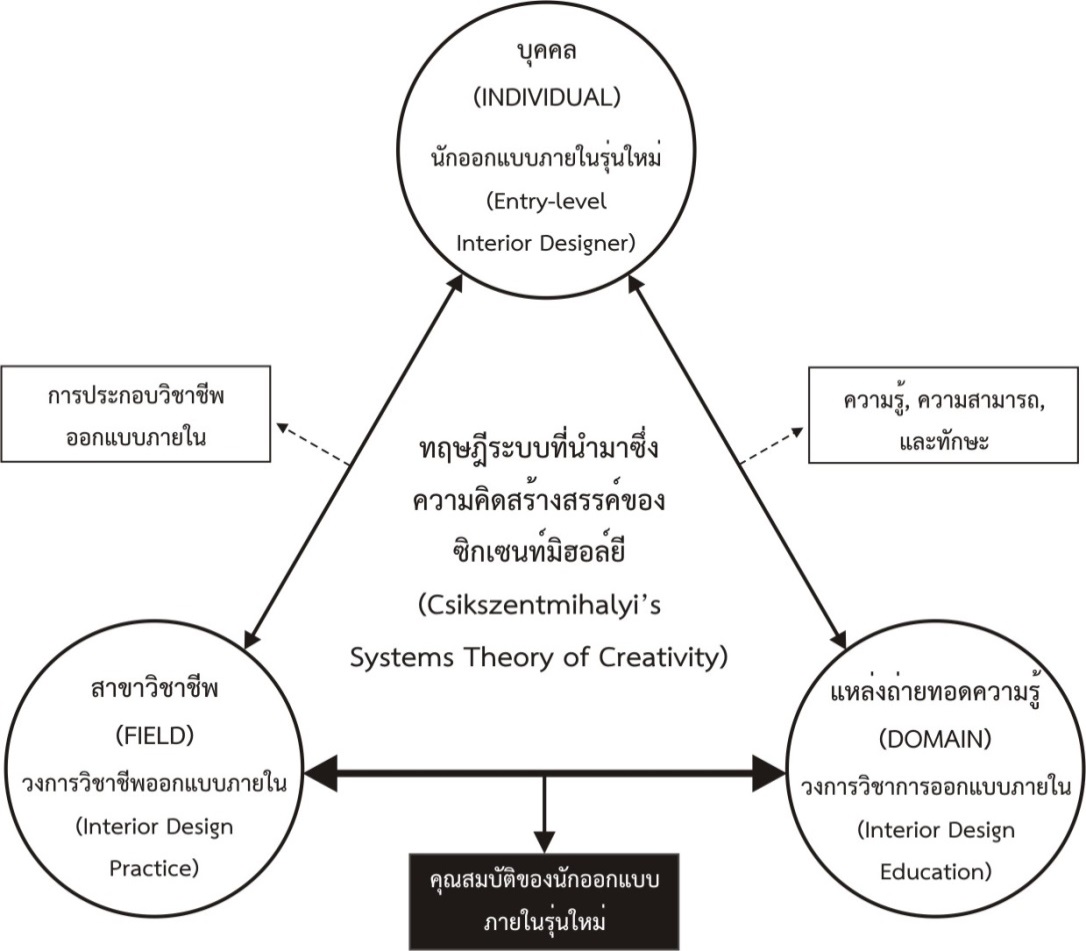Practitioners’ Viewpoints of Competencies for Entry-level Interior Designers
Main Article Content
Abstract
In the late 20th century, a major alteration of the interior design profession emerged based on its unclear status, which was related to the background in interior decoration and architectural design. The interior design practice was also recognized as more important than earlier. At that time, there were many research works examining necessary competencies for entry-level positions in order to fill in a gap between interior design practice and academic worlds. Presently, the interior design discipline has faced with significant challenges again. Nonetheless, studies related to the young designer’s competencies have disappeared, while the gap between the practice and academic sections has been growing. Thus, the current research aims to connect the mentioned gap by exploring the entry-level interior designer’s competencies based on viewpoints of experienced interior design practitioners. The semi-structured interview was applied to collect data from 21 senior interior designers. All interviews were transcribed and coded into three aspects of the competency, namely 1) abilities and skills, 2) personalities, and 3) strengths and weaknesses. The coded answers were analyzed with the literature review in order to conclude meaningful results. The results reveal that necessary competencies for entry-level interior designers, especially abilities and skills, are mainly influenced by the profession’s background in interior decoration and architectural design. Competencies related to personalities, strengths and weaknesses are primarily correlalted to the individual’s factors. Nonetheless, all three aspects of the competency can be cultivated and trained in the interior design education. The results will provide helpful guidelines to the academic section to develop curricula that are not only corresponded to the practitioner’s viewpoint, but also enhance young interior designers’ potential to progress the profession.
Downloads
Article Details

This work is licensed under a Creative Commons Attribution-NonCommercial-NoDerivatives 4.0 International License.
All material is licensed under the terms of the Creative Commons Attribution 4.0 International (CC-BY-NC-ND 4.0) License, unless otherwise stated. As such, authors are free to share, copy, and redistribute the material in any medium or format. The authors must give appropriate credit, provide a link to the license, and indicate if changes were made. The authors may do so in any reasonable manner, but not in any way that suggests the licensor endorses you or your use. The authors may not use the material for commercial purposes. If the authors remix, transform, or build upon the material, they may not distribute the modified material, unless permission is obtained from JARS. Final, accepted versions of the paper may be posted on third party repositories, provided appropriate acknowledgement to the original source is clearly noted.
References
American Society of Interior Designers. (2016). Becoming an interior designer. Retrieved July 8, 2016, from https://www.asid.org/content/becoming-interior-designer#.V39qEBIpq9c.
American Society of Interior Desingers. (2012). Tips for interior design graduates: What employers are looking for. Retrieved July 11, 2016, from https://www.asid.org/sites/default/files/TIPSFORGRADS.pdf.
Arch2o. (2017). Top 10 interior design schools around the world. Retrieved January 10, 2017, From http://www.arch2o.com/top-10-interior-design-schools-around-world/.
Architect Council of Thailand. (2012). Curriculums and educational institutions certified by Architect Council of Thailand. Retrieved January 10, 2016 from http://www.act.or.th/th/accredited_degree/.
Baker, I. J., & Sondhi, L. E. (1989). Entry-level competencies and attributes needed by interior design graduates: A survey of top interior design firms. Journal of Interior Design Educators and Research, 15(2), 35-40.
Chalayondecha, K., & Chaosiri, P. (2016). Viewpoints of architects in 4 different fields on professional development in the future. ACTNews, Issue January 2016, pp. 4-5.
Csikszentmihalyi, M. (1988). Society, culture, and person: A systems view of creativity. In R. J. Sternberg (Ed.), The nature of creativity: Contemporary psychological perspectives (pp. 325-339). Cambridge: Cambridge University Press.
Guest, R. C. (2010). Expectations of new graduates: A view from practice. In C. S. Martin & D. A. Guerin (Eds.), The state of the interior design profession (pp. 169-173). New York: Fairchild Books.
Hernecheck, P. J., Rettig, K. D., & Sherman, M. P. (1983). Professional viewpoints of competencies for interior design entry-level positions. Journal of Interior Design Educators and Research, 9(2), 7-13.
Horayangkura, V. (2015). Architectural programming: for the creation of built environment. Bangkok: G.B.P Center.
Kobnithikulwong, S. (2010). Thai creativity in interior design: A cross-cultural examination of practitioner evaluations on creative dimensions in entry-level portfolios. Doctoral dissertation, University of Florida, Florida.
Martin, C. S., & Guerin, D. A. (2010). The state of the interior design profession. New York: Fairchild Books.
Myers, C. (1982). Entry-level competencies needed by interior designers. Journal of Interior Design Educators and Research, 8(1), 19-24.
Nelson, M. S. C. (2010). Creativity in a season of technological change. In C. S. Martin & D. A. Guerin (Eds.), The state of the interior design profession (pp. 187-193). New York: Fairchild Books.
Pile, J. (2000). A history of interior design. London, Calmann & King.
Prasertsuk, S. (2015). Architectural composition for utilities and spatial connection in modern Thai architecture. Journal of Architecture/Planning Research and Studies, 12(1), 29-47.
Sims, R. C., & Koszalka, T. A. (2008). Competencies for the new-age instructional designer. Handbook of research on educational communications and technology, 3, 569-575.
Sthapitanonda, N. (2007). Conversations with architects. Bangkok: Li-zenn publishing.
Thaveeprungsriporn, D. P. (2011). Statement notion architecture. Bangkok: Li-zenn publishing.
Thompson, J. A., & Blossom, N. (2015). The handbook of the interior design. New York: John Wiley & Sons.
White, R. W. (1973). Sense of interpersonal competence: Two case studies and some reflection on origins. Interpersonal Dynamics (3rd ed.). Chicago: Dorsey Press.


